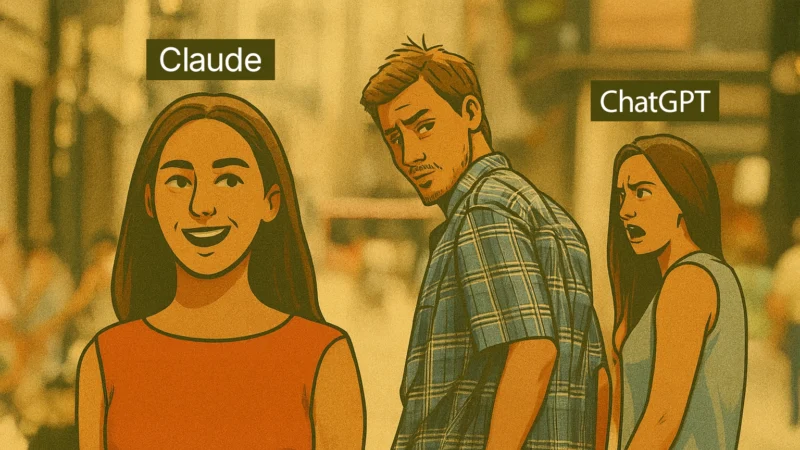From the Lab: Why I Can’t Quit GPT (Even When Claude is Better)

When you try new tools there’s always that phase where you’re like “wow, this is amazing, this changes everything!” I’ve been testing Claude this week and honestly, I went through that exact cycle. People get really excited when I present these new AI tools to them. Everyone’s like “oh this is so much better at reasoning” and “look at how it handles complex tasks” and yeah, Claude definitely surprised me with how it breaks down problems and synthesizes information.
But here’s what I realized after really putting it through its paces…
The biggest reason I keep using GPT isn’t because it’s technically better – it’s because of the memories. GPT knows me. At a level that’s honestly kind of wild. It knows my voice, my preferences, how I structure things. I can reference conversations from weeks ago and it remembers the context.
That’s why I can’t just switch, even when other tools might be superior at specific tasks.
What I Actually Tested
I ran real scenarios through all three platforms – not demo fluff, but actual work that needed to get done.
Content creation: Same brief to both Claude and GPT. Claude gave more nuanced output with better reasoning. But when I told GPT “write this in my style,” it nailed the tone immediately. No explanation needed.
Complex analysis: Claude wins here. It processes layered problems more sophisticatedly and gives structured insights. Really impressed with how it thinks through stuff.
Integration work: This was interesting. When I needed to connect different systems and APIs, Claude was actually better at understanding the technical requirements and providing cleaner integration approaches. It handled the complexity better than GPT.
Workflow continuity: This is where GPT dominates. I can say “remember that project structure from last month” and it knows exactly what I mean. With Claude, I start from zero every time.
Report generation: Claude does deeper analysis, but GPT already knows the format I like, the language I use, even my weird formatting preferences. Months of learning my style.
The Google Reality Check
Also tested Google’s AI integrations. If you’re living in their ecosystem, the connectors work smoothly. Good for quick tasks that need to plug into existing workflows. But again – no memory, no relationship building. Every interaction starts fresh.
My Actual Workflow Now
I’ve settled into this three-tool approach: Start with GPT for ideation because it has all my context and history. Jump to Claude when I need deeper analysis, complex reasoning, or cleaner integration work – it’s genuinely better at handling technical complexity. Then Google’s tools when I need something that plugs seamlessly into existing workflows.
But here’s the problem – those handoffs take work. I have to re-explain to Claude what GPT already understands. Context, tone preferences, project background. It’s like briefing new team members every single time.
The memory aspect is critical. I’ve been chatting with the same GPT instance for months. It’s learned how I think, approach problems, structure presentations. When I say “write this in my voice” it actually gets it right. When I reference “that framework we developed” it knows what I mean.
Why Memory Beats Features
Everyone’s focused on which model is smarter. And look, Claude probably is better at pure analytical tasks. But what matters day-to-day is continuity.
I don’t have to re-explain my context every time. That saves mental energy and speeds up everything. It’s like working with a teammate who knows your history versus bringing in a brilliant consultant who doesn’t know your company.
The consultant might be technically better, but the teammate moves faster with less friction.
I Quantified This
TTasks requiring previous context: GPT completes them about 3x faster because there’s no ramp-up time.New analytical assignments: Claude frequently creates superior initial drafts.Even when Claude’s output is superior, I still run it through GPT to “make this sound like me” or “adjust based on our previous discussions.” This is the worst part, though.
What This Means for Product Building
This got me thinking about product development too. We chase the latest features and better performance metrics. But sometimes the tool that knows your users, that has accumulated context, delivers more actual value than the technically superior option.
Consistency and relationship building matter in AI tools, just like with human collaborators.
The Bottom Line
Claude might be better at analysis. Google might have smoother integrations. The next model might be even better.
But the tool that knows how I work wins most of the time. That accumulated knowledge and context from months of collaboration is worth more than whatever the latest capabilities are.
I’m not willing to start over with a fresh model every time something new drops. The compound value of that memory is too important.
What’s your experience? Are you willing to restart with every new model, or does continuity matter to you too? Curious how others are handling this trade-off.
From the Lab – testing tools that might actually be useful for building products, not just what’s trending.








